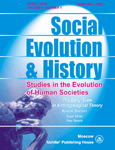Strange as it may seem, celebrity (as well as fame etc.) – despite its increasing role in modern life – is hardly included in the list of the resources , whose distribution defines the major forms of inequality. In the article, it is shown that the personal celebrity has become one of the most important and more and more desired resources in the modern world, which along with the power and wealth creates the major lines of inequality in a society. The subject of the present article is the analysis of characteristics of celebrities as a special elite stratum, which the author names ‘people of celebrity’. This elite includes the top workers of mass media; art, theatre, literature, cinema workers; representatives of show business and fashion; sportsmen, etc. The common feature of...
How we make sense of world politics and episodes of accelerated globalization depends on our historical scripts. Validating one person's historical script versus someone else's is a highly problematic exercise. Counterfactuals, however, can be utilized to at least suggest or reinforce the asserted significance of different versions of political-economic history. A series of eight counterfactuals encompassing the past 1000 years are harnessed to buttress the utility of framing the development of the modern world economy around a chain of lead economies and system leaders extending back to Sung China and forward to the United States.
www.sociostudies.org/journal/articles/143123/
www.sociostudies.org/journal/articles/143123/
Studies of social stratification in ancient Mesoamerica have taken two approaches. One is to identify legal or emic status positions as these may be defined by indigenous documents (nobility, commoners) or by prior theory (elite). Archaeologists using the direct historical approach can look for material patterns consistent with the historically named social categories. The archaeology then illustrates what is already known. The other approach is etic and offers inductive description of the social distribution of wealth. Commonly used indicators to rank individuals or households are domestic architecture, burials, and portable artifacts. These items are recovered from systematic excavations or systematic surface collecting. The objectives of the two approaches are not precisely...
Teaching & Researching Big History: Exploring a New Scholarly Field (Volgograd: ‘Uchitel’ Publishing House, 2014. — 368 pp. Edited by Leonid Grinin, David Baker, Esther Quaedackers, and Andrey Korotayev). This volume will be useful both for those who study interdisciplinary macroproblems and for specialists working in focused directions, as well as for those who are interested in evolutionary issues of Astrophysics, Geology, Biology, History, Anthropology, Linguistics and other areas of study. More than that, this edition will challenge and excite your vision of your own life and the exciting new discoveries going on around us! sociostudies.org/books/teaching_researching_big_history/
In 2010 Charles Spencer proposed the theory that there is a causal relation between state formation and territorial expansion. In the present article we formulate some objections against his views.
Authors: Henri J. M. Claessen and Renée R. Hagesteijn.
www.sociostudies.org/journal/articles/143120/
Authors: Henri J. M. Claessen and Renée R. Hagesteijn.
www.sociostudies.org/journal/articles/143120/
Special issue of the journal Social Evolution & History is devoted to the discussion on the Reformulation of the Theory of the Origin of the State made by its author
Origin of the Early State: A Reconsideration
www.sociostudies.org/journal/seh/archive/2012_2/
Origin of the Early State: A Reconsideration
www.sociostudies.org/journal/seh/archive/2012_2/
The Harappan Civilization was spread over large parts of western region of the Indian Subcontinent. Its earliest roots can be found from 7000 BC in Mehrgarh but its peak urban period is around 2500 to 1900 BC. It declined completely by 1300 BC. At its peak, it covered more than 30 per cent of the present landmass of the Indian Subcontinent. Its entire evidence is archaeological.
www.sociostudies.org/journal/articles/140624/
www.sociostudies.org/journal/articles/140624/
Видеозапись лекции Ж. И. Резниковой «Животное в человеке — человеческое в животных» (на русском языке) www.socionauki.ru/authors/reznikova_zh_i/
"Животное в человеке - человеческое в животных" - лекция Ж. И. Резниковой
 http://www.socionauki.ru/authors/rezni..
http://www.socionauki.ru/authors/rezni..
Видеозапись лекции Жанны Ильничны Резниковой «Животное в человеке — человеческое в животных» (на рсском языке)
видео с лекции Уолтера Альвареса Earth History in the Broadest Possible Context (лекция на английском языке) www.socionauki.ru/authors/alvarez_w/?lang=ru





